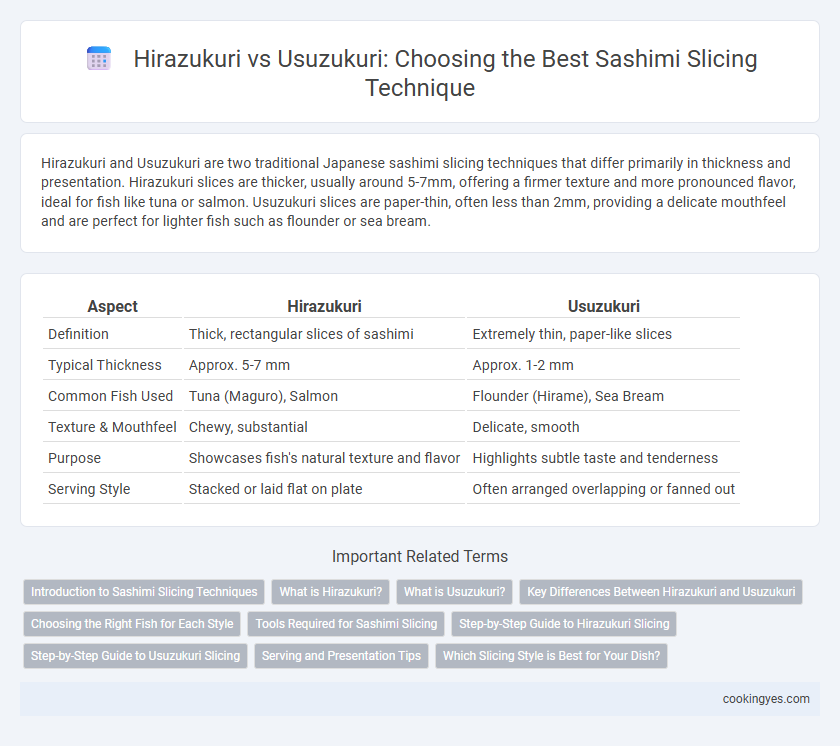Hirazukuri and Usuzukuri are two traditional Japanese sashimi slicing techniques that differ primarily in thickness and presentation. Hirazukuri slices are thicker, usually around 5-7mm, offering a firmer texture and more pronounced flavor, ideal for fish like tuna or salmon. Usuzukuri slices are paper-thin, often less than 2mm, providing a delicate mouthfeel and are perfect for lighter fish such as flounder or sea bream.
Table of Comparison
| Aspect | Hirazukuri | Usuzukuri |
|---|---|---|
| Definition | Thick, rectangular slices of sashimi | Extremely thin, paper-like slices |
| Typical Thickness | Approx. 5-7 mm | Approx. 1-2 mm |
| Common Fish Used | Tuna (Maguro), Salmon | Flounder (Hirame), Sea Bream |
| Texture & Mouthfeel | Chewy, substantial | Delicate, smooth |
| Purpose | Showcases fish's natural texture and flavor | Highlights subtle taste and tenderness |
| Serving Style | Stacked or laid flat on plate | Often arranged overlapping or fanned out |
Introduction to Sashimi Slicing Techniques
Hirazukuri and Usuzukuri represent two fundamental sashimi slicing techniques that influence texture and flavor presentation. Hirazukuri involves thick, rectangular cuts ideal for fatty fish like tuna, enhancing rich texture and mouthfeel, while Usuzukuri produces paper-thin slices perfect for delicate fish such as flounder, emphasizing subtle taste and tenderness. Mastery of these methods allows chefs to showcase the unique qualities of each fish species, optimizing sashimi's culinary experience.
What is Hirazukuri?
Hirazukuri is a traditional sashimi slicing technique characterized by thick, rectangular cuts of fish, typically about 5-7mm thick, showcasing the fish's texture and flavor. This method is commonly used for fish like tuna and salmon, offering a firmer bite and a more substantial mouthfeel compared to thinner slices. The precision of Hirazukuri enhances the sashimi eating experience by balancing visual appeal with texture and taste.
What is Usuzukuri?
Usuzukuri is a sashimi slicing technique that involves cutting fish into ultra-thin, translucent slices, typically ranging from 1 to 2 millimeters in thickness. This method is especially popular for delicate white fish such as flounder or sea bream, enhancing their subtle flavors and smooth texture. Unlike Hirazukuri, which produces thicker rectangular slices, Usuzukuri emphasizes fineness and presentation, allowing the natural freshness of the fish to shine through.
Key Differences Between Hirazukuri and Usuzukuri
Hirazukuri sashimi slices are thick and rectangular, typically measuring about 5mm, highlighting the fish's texture and flavor, commonly used for tuna and salmon. Usuzukuri features ultra-thin slices, often less than 1mm, arranged to highlight delicate presentation and subtle taste, ideal for white fish like flounder. The primary difference lies in slice thickness and presentation, influencing the sashimi's mouthfeel and visual appeal.
Choosing the Right Fish for Each Style
Hirazukuri, characterized by thick, rectangular slices, suits firmer, fatty fish like tuna and salmon to highlight texture and richness. Usuzukuri requires ultra-thin slicing ideal for delicate, translucent fish such as flounder or sea bream, emphasizing subtle flavors and a tender mouthfeel. Selecting the appropriate fish ensures the sashimi style complements both the fish's texture and taste, enhancing the overall dining experience.
Tools Required for Sashimi Slicing
Hirazukuri sashimi slicing requires a heavy, thick-bladed knife such as the yanagiba or deba, designed to cut through firm fish with precision on thick, uniform blocks. Usuzukuri slicing demands an exceptionally sharp, thin, and flexible knife to achieve paper-thin, translucent slices, often using a long yanagiba specialized for delicate cuts. Both techniques emphasize the importance of knife sharpness and blade quality to maintain texture and presentation in high-grade sashimi preparation.
Step-by-Step Guide to Hirazukuri Slicing
Hirazukuri slicing for sashimi involves cutting fish into thick, rectangular pieces approximately 1 cm thick, providing a firm texture ideal for species like tuna or salmon. Begin by placing the fillet skin-side down on a cutting board, then hold your knife at a 90-degree angle and make straight, downward strokes to achieve uniform, even slices. This method preserves the sashimi's natural flavor and texture, differentiating it from Usuzukuri, which features ultra-thin, translucent slices suited for delicate fish such as flounder.
Step-by-Step Guide to Usuzukuri Slicing
Usuzukuri slicing technique requires an ultra-sharp knife and precise angle control to create thin, translucent sashimi slices often used for delicate fish like flounder. Begin by securing the fish fillet firmly, then slice in a single, smooth motion from the heel to the tip of the blade, maintaining a 10-15 degree angle for paper-thin cuts. Properly executed Usuzukuri enhances the texture and flavor presentation in sashimi compared to the thicker Hirazukuri slices, which are typically 10mm thick and cube-shaped.
Serving and Presentation Tips
Hirazukuri sashimi slices are thick, roughly 1 cm, ideal for richer fish like tuna, offering a satisfying texture that pairs well with bold soy-based dipping sauces. Usuzukuri slices are paper-thin, usually less than 2 mm, perfect for delicate white fish such as flounder, enhancing presentation with their translucent appearance and arranged in overlapping circular patterns to highlight finesse. Serving Hirazukuri with vivid garnishes like shiso leaves and daikon contrasts the thickness, while Usuzukuri benefits from minimalistic plating to emphasize elegance and the fish's freshness.
Which Slicing Style is Best for Your Dish?
Hirazukuri, featuring thick, rectangular slices typically measuring about 10-15mm, is ideal for fatty fish like tuna or salmon, emphasizing texture and richness in dishes like maguro sashimi. Usuzukuri offers paper-thin, translucent slices, usually under 3mm, perfect for delicate white fish such as flounder, highlighting subtle flavors and enhancing presentation in light, refreshing sashimi servings. Choosing between Hirazukuri and Usuzukuri depends on the fish type and desired dining experience, balancing texture intensity and flavor delicacy in sashimi preparation.
Hirazukuri vs Usuzukuri for sashimi slicing Infographic

 cookingyes.com
cookingyes.com